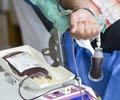Blood Donation - Process
Blood donation is carried out under the supervision of trained, skilled technicians. The entire procedure, from start to finish, does not take more than 45 minutes.
The blood is usually drawn from the median cubital vein, from the inside of the elbow. An antiseptic such as iodine is ued to clean the skin above this vein. This helps to prevent bacterial infection at the site of puncture and also helps to prevent the blood drawn from being infected.
A tourniquet may be used to elevate the blood pressure in the veins of the arm. This helps to ease and speed up the process. Sometimes the donor is given an object to squeeze repeatedly in order to increase blood flow to the targeted vein. Invariably a needle with a larger guage is used inorder to minimise the shearing forces that can cause damage to the RBCs.
A mild sting may be experienced when the needle is inserted, but there should be no pain during the donation.
There are two main procedures that are used to draw blood from a donor.
The first and the most common method is when whole blood is drawn from the donor and is collected in a plastic bag that contains anticoagulants and preservatives such as sodium citrate, phosphate, dextrose or adenine. The collected blood seperated into its components (mainly the RBCs and the plasma) and stored. It must be noted that most recipients need only certain components and do not require whole blood. Plasma can be used for transfusions and also to make medications. This is a carry over from the World War II times when dried plasma was usEd to treat wounds.
On an average 450-500 ml of blood is drawn from one individual at a time. This amount of blood, along with the anti coagulants present in the collection bag is referred to as ‘one unit’ of blood.
The second method called apheresis consists of drawing blood from the donor, seperating the components using a centrifuge, storing the component required for transfusion and returning the remaining components to the donor. Usually the RBCs are transferred back to the donor while the plasma and platelets are put to good use. Apheresis may be carried out using specifically designed instruments.
Whole blood, when kept in CPDA anti coagulant solution at 2 - 4 deg C, can be stored up to 35 days, but the demand is far greater than the supply and the collected blood is used up much before its expiry date.












